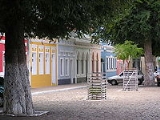
Floresta, Pernambuco
Encyclopedia
Floresta is a city in the Brazil
ian state of Pernambuco
. Situated at latitude
08º36'04" South and at longitude
38º34'07" West, being to an altitude of 316 metres. Its population was estimated in 2009 of 28.100 inhabitants, according with IBGE
.
Has an area of 3690,3 km².
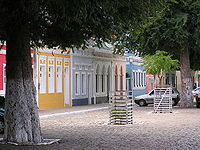
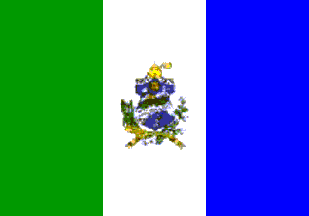
) traces its origins to the 18th century farms of Curralinho and Paus Pretos, but it was the Fazenda Grande (big farm), on the right bank of the rio Pajeú (Pajeú river), that saw the first inhabitants of Floresta. In the second half of the 18th century, the farm served as a temporary shelter for the cattle that came from Bahia
to supply Pernambuco
sugar devices with animal power.
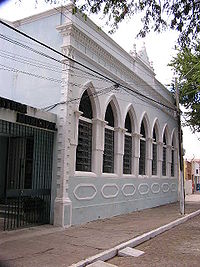 Around the particular oratory, raised in 1777, that would later come to be the chapel of the Bom Jesus dos Aflitos, the town appeared named as Fazenda Grande. The proprietors of the Fazenda Grande, captain Jose Maciel Pear tree and his wife D. Joana de Souza Silveira, had donated their lands to the Bom Jesus dos Aflitos, in 1778, in the notary's office of the Farm Riacho do Navio.
Around the particular oratory, raised in 1777, that would later come to be the chapel of the Bom Jesus dos Aflitos, the town appeared named as Fazenda Grande. The proprietors of the Fazenda Grande, captain Jose Maciel Pear tree and his wife D. Joana de Souza Silveira, had donated their lands to the Bom Jesus dos Aflitos, in 1778, in the notary's office of the Farm Riacho do Navio.
The easy access to water and the spirit of Christianity had attracted people to the place. After few years, the town of Fazenda Grande was raised to the category of Village on 31 March 1846, by means of a project that became Provincial Law no. 153, presented for the representative of Flores
, city also bathed by the Pajeú River
, of which was unlinked.
In 1849, as a punishment for its active participation in Revolução Praieira, the Vila de Floresta was incorporated to the town of Tacaratu
, however, in 1864, the Term of the Judicial district was restored.
As a village, and with the advent of Republic, Floresta had as the first mayor Mr. Cel. Fausto Serafim de Souza Ferraz, who assumed in 1892. On 20 June 1907, through state Law no. 867, it was raised to the category of city. After four days the "Sociedade Progressista Arborizadora" was created for the florestanos João Gomes Barbosa and Alfredo Barros, being the first one called by Álvaro Ferraz, in its book Floresta, Pai dos Tamarindos.
The city of Floresta is classified in first place in Pernambuco, as the greatest rearing facility of caprinos (goat), and also one of the greatest tomato
producing regions.
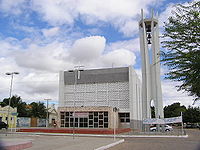 In 1897, the first Church was constructed, where today sits the Cathedral of the Bom Jesus. It held the image of the Padroeiro, being the primitive church, a monument of History and Faith there, under the sponsorship of Nª Srª do Rosário.
In 1897, the first Church was constructed, where today sits the Cathedral of the Bom Jesus. It held the image of the Padroeiro, being the primitive church, a monument of History and Faith there, under the sponsorship of Nª Srª do Rosário.
Floresta was seat of the first Roman Catholic Diocese
of the Sertão Nordestino, created in 1910 was composed of 18 parishes:
Exu, Ouricuri
, Petrolina
, Granito
, Leopoldina (current Parnamirim
), Salgueiro
, Boa Vista, Cabrobó
, Belém do São Francisco, Floresta, Vila Bela (current Serra Talhada
), Belmonte
, São José do Egito
, Triunfo
, Flores, Afogados da Ingazeira
, Alagoa de Baixo (current Sertânia
) e Tacaratu.
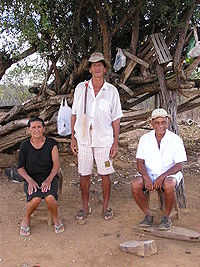 The first bishop of the diocese was D. Augusto Álvaro da Silva, who later served as Cardinal
The first bishop of the diocese was D. Augusto Álvaro da Silva, who later served as Cardinal
Archbishop of Bahia.
Its exuberant nature, also with some typical vegetal species of the Amazon region, was studied by important researchers, between them prof. Vasconcelos Sobrinho.
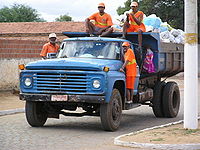
, especially creation of goat
s, cattle
, sheeps, ; and plantations of tomatoes, melon
s, water melons and onion
s. Floresta, it is one of the largeste creators of goats in all state, with over than 110 thousand heads in 2007.
Economy by Sector
Brazil
Brazil , officially the Federative Republic of Brazil , is the largest country in South America. It is the world's fifth largest country, both by geographical area and by population with over 192 million people...
ian state of Pernambuco
Pernambuco
Pernambuco is a state of Brazil, located in the Northeast region of the country. To the north are the states of Paraíba and Ceará, to the west is Piauí, to the south are Alagoas and Bahia, and to the east is the Atlantic Ocean. There are about of beaches, some of the most beautiful in the...
. Situated at latitude
Latitude
In geography, the latitude of a location on the Earth is the angular distance of that location south or north of the Equator. The latitude is an angle, and is usually measured in degrees . The equator has a latitude of 0°, the North pole has a latitude of 90° north , and the South pole has a...
08º36'04" South and at longitude
Longitude
Longitude is a geographic coordinate that specifies the east-west position of a point on the Earth's surface. It is an angular measurement, usually expressed in degrees, minutes and seconds, and denoted by the Greek letter lambda ....
38º34'07" West, being to an altitude of 316 metres. Its population was estimated in 2009 of 28.100 inhabitants, according with IBGE
IBGE
The Brazilian Institute of Geography and Statistics or IBGE , is the agency responsible for statistical, geographic, cartographic, geodetic and environmental information in Brazil...
.
Has an area of 3690,3 km².


History
Floresta (means forestForest
A forest, also referred to as a wood or the woods, is an area with a high density of trees. As with cities, depending where you are in the world, what is considered a forest may vary significantly in size and have various classification according to how and what of the forest is composed...
) traces its origins to the 18th century farms of Curralinho and Paus Pretos, but it was the Fazenda Grande (big farm), on the right bank of the rio Pajeú (Pajeú river), that saw the first inhabitants of Floresta. In the second half of the 18th century, the farm served as a temporary shelter for the cattle that came from Bahia
Bahia
Bahia is one of the 26 states of Brazil, and is located in the northeastern part of the country on the Atlantic coast. It is the fourth most populous Brazilian state after São Paulo, Minas Gerais and Rio de Janeiro, and the fifth-largest in size...
to supply Pernambuco
Pernambuco
Pernambuco is a state of Brazil, located in the Northeast region of the country. To the north are the states of Paraíba and Ceará, to the west is Piauí, to the south are Alagoas and Bahia, and to the east is the Atlantic Ocean. There are about of beaches, some of the most beautiful in the...
sugar devices with animal power.

The easy access to water and the spirit of Christianity had attracted people to the place. After few years, the town of Fazenda Grande was raised to the category of Village on 31 March 1846, by means of a project that became Provincial Law no. 153, presented for the representative of Flores
Flores
Flores is one of the Lesser Sunda Islands, an island arc with an estimated area of 14,300 km² extending east from the Java island of Indonesia. The population was 1.831.000 in the 2010 census and the largest town is Maumere. Flores is Portuguese for "flowers".Flores is located east of Sumbawa...
, city also bathed by the Pajeú River
Pajeú River
The Pajeú River is a tributary of the São Francisco River in Pernambuco state of northeastern Brazil. The Pajeú originates on the Borborema Plateau, and flows southwest to join the São Francisco....
, of which was unlinked.
In 1849, as a punishment for its active participation in Revolução Praieira, the Vila de Floresta was incorporated to the town of Tacaratu
Tacaratu
Tacaratu is a town in the state of Pernambuco, Brazil. The population in 2009, according with IBGE is 22,231 and the area is 1264.5 km².-Geography:* State - Pernambuco* Region - São Francisco Pernambucano...
, however, in 1864, the Term of the Judicial district was restored.
As a village, and with the advent of Republic, Floresta had as the first mayor Mr. Cel. Fausto Serafim de Souza Ferraz, who assumed in 1892. On 20 June 1907, through state Law no. 867, it was raised to the category of city. After four days the "Sociedade Progressista Arborizadora" was created for the florestanos João Gomes Barbosa and Alfredo Barros, being the first one called by Álvaro Ferraz, in its book Floresta, Pai dos Tamarindos.
The city of Floresta is classified in first place in Pernambuco, as the greatest rearing facility of caprinos (goat), and also one of the greatest tomato
Tomato
The word "tomato" may refer to the plant or the edible, typically red, fruit which it bears. Originating in South America, the tomato was spread around the world following the Spanish colonization of the Americas, and its many varieties are now widely grown, often in greenhouses in cooler...
producing regions.
Religious history

Floresta was seat of the first Roman Catholic Diocese
Roman Catholic Diocese of Pesqueira
The Roman Catholic Diocese of Pesqueira is a diocese located in the city of Pesqueira in the Ecclesiastical province of Olinda e Recife in Brazil.-History:* December 5, 1910: Established as Diocese of Floresta from the Diocese of Olinda...
of the Sertão Nordestino, created in 1910 was composed of 18 parishes:
Exu, Ouricuri
Ouricuri
Ouricuri it's a city in the state of Pernambuco, Brazil. It's located in the mesoregion of Sertão Pernambucano . Ouricuri has a total area of 2.423 square kilometers and had an estimated population of 66.978 inhabitants in 2009 according with IBGE....
, Petrolina
Petrolina
Petrolina is a city located in the southernmost point of the state of Pernambuco, in Brazil. The population was 281.851 in 2009 in a total area of 4756.8 km²....
, Granito
Granito
Granito is a city in the state of Pernambuco, Brazil. The population in 2009, according with IBGE was 6.944 inhabitants and the total area is 521.86 km².-Geography:* State - Pernambuco* Region - Sertão Pernambucano...
, Leopoldina (current Parnamirim
Parnamirim
Parnamirim is a city in Rio Grande do Norte, Brazil. It is located at around . Augusto Severo International Airport, the airport serving the city of Natal, is located there....
), Salgueiro
Salgueiro
Salgueiro is a city in Pernambuco, Brazil. It's located in the mesoregion of Sertão Pernambucano . Salgueiro has a total area of 1639.3 square kilometers and had an estimated population of 55.435 inhabitants in 2009 according with IBGE....
, Boa Vista, Cabrobó
Cabrobó
Cabrobó is a city in the Brazilian state of Pernambuco, 536 km away from the state's capital, Recife. The population in 2009, according with IBGE was 30.432 and the area is 1658.08 km².-Geography:* State - Pernambuco...
, Belém do São Francisco, Floresta, Vila Bela (current Serra Talhada
Serra Talhada
Serra Talhada is a city in the state of Pernambuco, Brazil. It is located at 07º59'31" South and 38º17'54" West, at an altitude of 429 metres. As of 2009, its estimated population by IBGE was 80.294 people. Its area is approximately 2980 km sq.-History:...
), Belmonte
Belmonte
-People and titles:*Prince Belmonte or Princess Belmonte, a Spanish and Italian noble title*Domenico Pignatelli di Belmonte, a Cardinal of the Roman Catholic Church*Gennaro Granito Pignatelli di Belmonte, a Cardinal of the Roman Catholic Church...
, São José do Egito
São José do Egito
São José do Egito is a city in the state of Pernambuco, Brazil. The population in 2009, according with IBGE was 31,792 and the area is 791.9 km².-Geography:* State - Pernambuco* Region - Sertão Pernambucano...
, Triunfo
Triunfo
Triunfo is a municipality in the state Rio Grande do Sul, Brazil.It is also the richest municipality in Brazil, with a per capita income of R$122,750 .-See also:*List of municipalities in Rio Grande do Sul...
, Flores, Afogados da Ingazeira
Afogados da Ingazeira
Afogados da Ingazeira is a Brazilian municipality in the state of Pernambuco. The population in 2009, according with IBGE was 35.528 and the total area is 377.86 km². In 2000, Afogados da Ingazeira had the second highest Human Development Index in the Alto do Pajeú sertão region of...
, Alagoa de Baixo (current Sertânia
Sertânia
Sertânia is a city in the state of Pernambuco, Brazil. The population in 2009, according with IBGE was 35.914 inhabitants and the total area is 2421,51 km².-Geography:* State - Pernambuco* Region - Sertão Pernambucano...
) e Tacaratu.

Cardinal (Catholicism)
A cardinal is a senior ecclesiastical official, usually an ordained bishop, and ecclesiastical prince of the Catholic Church. They are collectively known as the College of Cardinals, which as a body elects a new pope. The duties of the cardinals include attending the meetings of the College and...
Archbishop of Bahia.
Serra Negra
Serra Negra it is the first biological reserve of Brazil, being instituted by the Decree 28348, of 7 de junho of 1950, with an area of 1.100ha and 5 km (3 mi) of extension.Its exuberant nature, also with some typical vegetal species of the Amazon region, was studied by important researchers, between them prof. Vasconcelos Sobrinho.

Economy
The main economic activities in Floresta are based in commerce and agribusinessAgribusiness
In agriculture, agribusiness is a generic term for the various businesses involved in food production, including farming and contract farming, seed supply, agrichemicals, farm machinery, wholesale and distribution, processing, marketing, and retail sales....
, especially creation of goat
Goat
The domestic goat is a subspecies of goat domesticated from the wild goat of southwest Asia and Eastern Europe. The goat is a member of the Bovidae family and is closely related to the sheep as both are in the goat-antelope subfamily Caprinae. There are over three hundred distinct breeds of...
s, cattle
Cattle
Cattle are the most common type of large domesticated ungulates. They are a prominent modern member of the subfamily Bovinae, are the most widespread species of the genus Bos, and are most commonly classified collectively as Bos primigenius...
, sheeps, ; and plantations of tomatoes, melon
Melon
thumb|200px|Various types of melonsThis list of melons includes members of the plant family Cucurbitaceae with edible, fleshy fruit e.g. gourds or cucurbits. The word "melon" can refer to either the plant or specifically to the fruit...
s, water melons and onion
Onion
The onion , also known as the bulb onion, common onion and garden onion, is the most widely cultivated species of the genus Allium. The genus Allium also contains a number of other species variously referred to as onions and cultivated for food, such as the Japanese bunching onion The onion...
s. Floresta, it is one of the largeste creators of goats in all state, with over than 110 thousand heads in 2007.
Economic Indicators
| Population | GDP x(1000 R$). | GDP pc (R$) | PE Pernambuco Pernambuco is a state of Brazil, located in the Northeast region of the country. To the north are the states of Paraíba and Ceará, to the west is Piauí, to the south are Alagoas and Bahia, and to the east is the Atlantic Ocean. There are about of beaches, some of the most beautiful in the... |
|---|---|---|---|
| 28.100 | 152.769 | 5.733 | 0.25 % |
Economy by Sector
| Primary sector | Secondary sector | Service sector |
|---|---|---|
| 14.67 % | 12.64 % | 72.69 % |
Health Indicators
| HDI Human Development Index The Human Development Index is a composite statistic used to rank countries by level of "human development" and separate "very high human development", "high human development", "medium human development", and "low human development" countries... (2000) |
Hospitals (2007) | Hospitals beds (2007) | Children's Mortality every 1000 (2005) |
|---|---|---|---|
| 0.698 | 2 | 140 | 35 |

